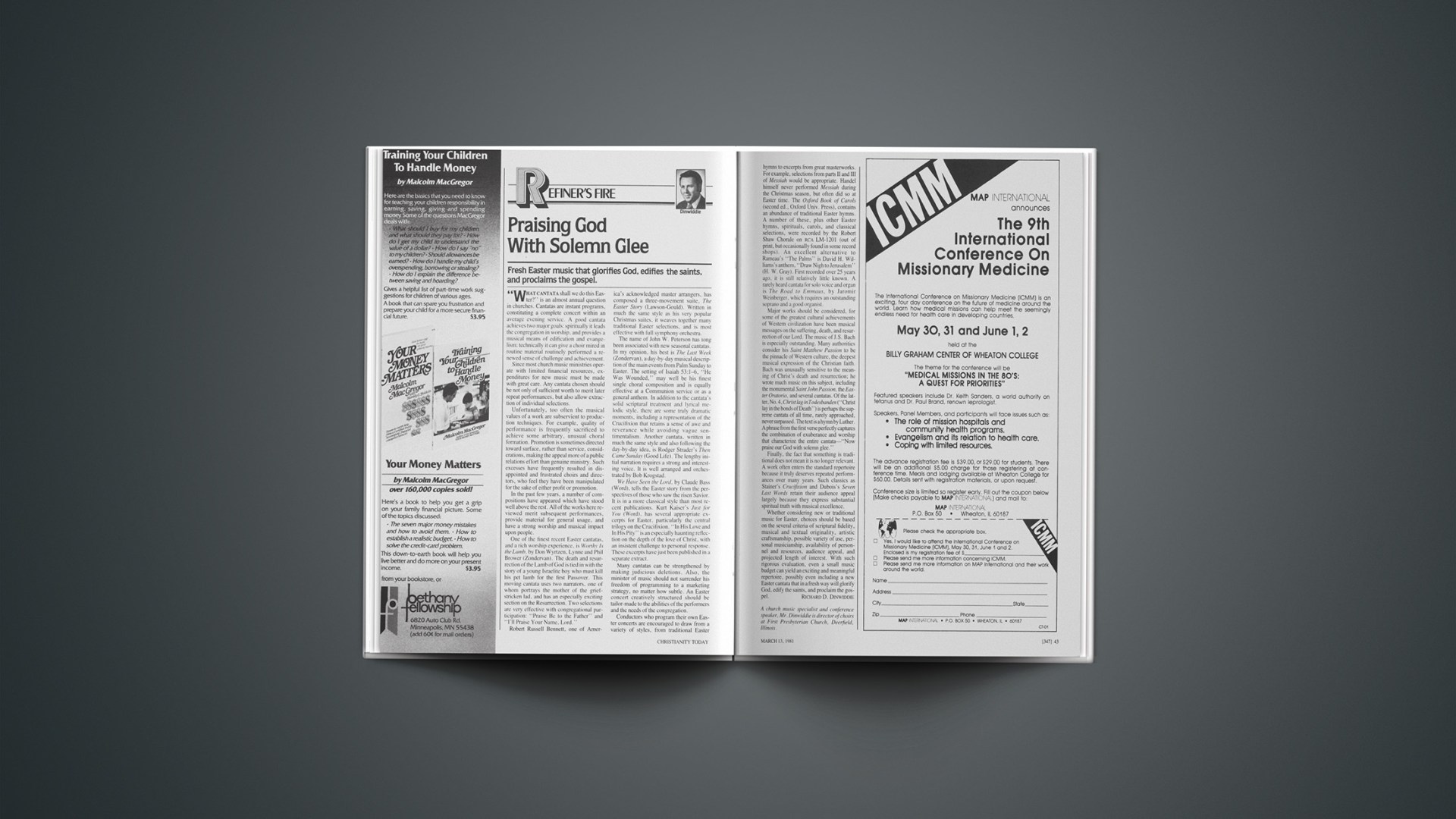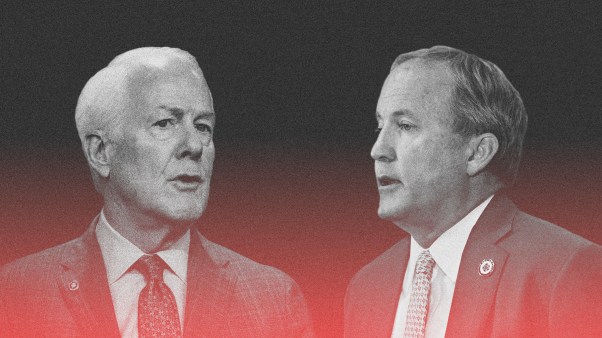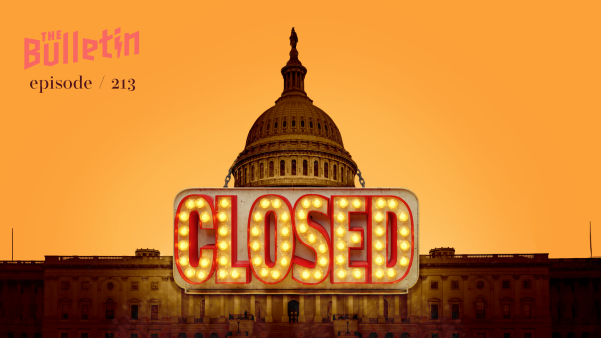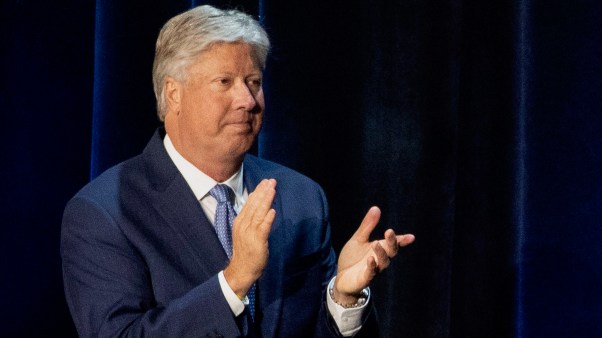Fresh Easter music that glorifies God, edifies the saints, and proclaims the gospel.
“What cantata shall we do this Easter?” is an almost annual question in churches. Cantatas are instant programs, constituting a complete concert within an average evening service. A good cantata achieves two major goals: spiritually it leads the congregation in worship, and provides a musical means of edification and evangelism; technically it can give a choir mired in routine material routinely performed a renewed sense of challenge and achievement.
Since most church music ministries operate with limited financial resources, expenditures for new music must be made with great care. Any cantata chosen should be not only of sufficient worth to merit later repeat performances, but also allow extraction of individual selections.
Unfortunately, too often the musical values of a work are subservient to production techniques. For example, quality of performance is frequently sacrificed to achieve some arbitrary, unusual choral formation. Promotion is sometimes directed toward surface, rather than service, considerations, making the appeal more of a public relations effort than genuine ministry. Such excesses have frequently resulted in disappointed and frustrated choirs and directors, who feel they have been manipulated for the sake of either profit or promotion.
In the past few years, a number of compositions have appeared which have stood well above the rest. All of the works here reviewed merit subsequent performances, provide material for general usage, and have a strong worship and musical impact upon people.
One of the finest recent Easter cantatas, and a rich worship experience, is Worthy Is the Lamb, by Don Wyrtzen, Lynne and Phil Brower (Zondervan). The death and resurrection of the Lamb of God is tied in with the story of a young Israelite boy who must kill his pet lamb for the first Passover. This moving cantata uses two narrators, one of whom portrays the mother of the grief-stricken lad, and has an especially exciting section on the Resurrection. Two selections are very effective with congregational participation: “Praise Be to the Father” and “I’ll Praise Your Name. Lord.”
Robert Russell Bennett, one of America’s acknowledged master arrangers, has composed a three-movement suite. The Easter Story (Lawson-Gould). Written in much the same style as his very popular Christmas suites, it weaves together many traditional Easter selections, and is most effective with full symphony orchestra.
The name of John W. Peterson has long been associated with new seasonal cantatas. In my opinion, his best is The Last Week (Zondervan), a day-by-day musical description of the main events from Palm Sunday to Easter. The setting of Isaiah 53:1–6, “He Was Wounded,” may well be his finest single choral composition and is equally effective at a Communion service or as a general anthem. In addition to the cantata’s solid scriptural treatment and lyrical melodic style, there are some truly dramatic moments, including a representation of the Crucifixion that retains a sense of awe and reverance while avoiding vague sentimentalism. Another cantata, written in much the same style and also following the day-by-day idea, is Rodger Strader’s Then Came Sunday (Good Life). The lengthy initial narration requires a strong and interesting voice. It is well arranged and orchestrated by Bob Krogstad.
We Have Seen the Lord, by Claude Bass (Word), tells the Easter story from the perspectives of those who saw the risen Savior. It is in a more classical style than most recent publications. Kurt Kaiser’s Just for You (Word), has several appropriate excerpts for Easter, particularly the central trilogy on the Crucifixion. “In His Love and In His Pity” is an especially haunting reflection on the depth of the love of Christ, with an insistent challenge to personal response. These excerpts have just been published in a separate extract.
Many cantatas can be strengthened by making judicious deletions. Also, the minister of music should not surrender his freedom of programming to a marketing strategy, no matter how subtle. An Easter concert creatively structured should be tailor-made to the abilities of the performers and the needs of the congregation.
Conductors who program their own Easter concerts are encouraged to draw from a variety of styles, from traditional Easter hymns to excerpts from great masterworks. For example, selections from parts II and III of Messiah would be appropriate. Handel himself never performed Messiah during the Christmas season, but often did so at Easter time. The Oxford Book of Carols (second ed., Oxford Univ. Press), contains an abundance of traditional Easter hymns. A number of these, plus other Easter hymns, spirituals, carols, and classical selections, were recorded by the Robert Shaw Chorale on RCA LM-1201 (out of print, but occasionally found in some record shops). An excellent alternative to Rameau’s “The Palms” is David H. Williams’s anthem, “Draw Nigh to Jerusalem” (H. W. Gray). First recorded over 25 years ago, it is still relatively little known. A rarely heard cantata for solo voice and organ is The Road to Emmaus, by Jaromir Weinberger, which requires an outstanding soprano and a good organist.
Major works should be considered, for some of the greatest cultural achievements of Western civilization have been musical messages on the suffering, death, and resurrection of our Lord. The music of J.S. Bach is especially outstanding. Many authorities consider his Saint Matthew Passion to be the pinnacle of Western culture, the deepest musical expression of the Christian faith. Bach was unusually sensitive to the meaning of Christ’s death and resurrection; he wrote much music on this subject, including the monumental Saint John Passion, the Easter Oratorio, and several cantatas. Of the latter, No. 4, Christ lag in Todesbanden (“Christ lay in the bonds of Death”) is perhaps the supreme cantata of all time, rarely approached, never surpassed. The text is a hymn by Luther. A phrase from the first verse perfectly captures the combination of exuberance and worship that characterize the entire cantata—“Now praise our God withsolemnglee.”
Finally, the fact that something is traditional does not mean it is no longer relevant. A work often enters the standard repertoire because it truly deserves repeated performances over many years. Such classics as Stainer’s Crucifixion and Dubois’s Seven Last Words retain their audience appeal largely because they express substantial spiritual truth with musical excellence.
Whether considering new or traditional music for Easter, choices should be based on the several criteria of scriptural fidelity, musical and textual originality, artistic craftsmanship, possible variety of use, personal musicianship, availability of personnel and resources, audience appeal, and projected length of interest. With such rigorous evaluation, even a small music budget can yield an exciting and meaningful repertoire, possibly even including a new Easter cantata that in a fresh way will glorify God, edify the saints, and proclaim the gospel.
RICHARD D. DINWIDDIE1A church music specialist and conference speaker, Mr. Dinwiddie is director of choirs at First Presbyterian Church, Deerfield, Illinois.










